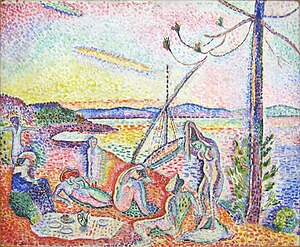Colours became charges of dynamite. They were supposed to discharge light. Everything could be raised above the real.
ANDRE DERAIN
At the 1905 Salon d'Automne in Paris, a group of artists exhibited paintings so shocking - the colours so strong and brash, their application so spontaneous and rough- that they were immediately called les fauves (the wild beasts). The most prominent of those artists were ;
 |
| Henri Matisse |
 |
| The Green Line by Matisse |
 |
| André Derain |
 |
| The Turning Road by Derain |
 |
| Maurice de Vlaminck |
 |
| The Circus by Vlaminck |
Georges Rouault of Expressionism was also interested in this wave and had some pieces on this movement.
Fauvism was the first of the avant-garde
(Avant-garde represents a pushing of the boundaries of what is accepted as the norm or the status quo, primarily in the cultural realm.) movements of 20th century to shake up the art world, but the Fauves were never a consciously organised movement with an agreed agenda. Matisse, the oldest and most established, soon became known as "the king of the wild beasts".
In "Notes of a Painter", published in La grande Revue in 1908, Matisse clarified his conception of the role of art:
"What I am after, above all, is expression....I am unable to distinguish between the feeling I have for life and my way of expressing it.... The chief aim of colour should be to serve expression as well as possible.... What I dream of is an art of balance, of purity and serenity devoid of troubling or depressing subject matter, an art which might be for every mental worker, be the business man or writer, like an appeasing influence, like a menthal soother, something like a good armchair in which to rest from physical fatigue."
 |
| Luxe, Calme et Volupté, 1904, Matisse (Luxury,Calm and Pleasure) |
This painting was exhibited in 1905 and Signac bought it immediately. Raoul Dufy said " In front of this picture, I understood all the new principles; Impressionism lost its charm for me as I contemplated this miracle of imagination produced by drawing and colour."
It should be notted that many of the Fauves (Matisse, Rouault, Camoin, Marquet, Manguin) studied under Gustave Moreau (Symbolism), whose open-minded attitudes, originality and belief in the expressive power of pure colour was inspirational.
Van Gogh had an overwhelming influence on Vlaminck. He first saw Van Gogh's work at an exhibiton in 1901, and confessed shortly after that he loved him more than his own father. He adopted the habit of squeezing paint directly from the tube onto the canvas calling attention to the physicality of material, as in Picnic in the Country.
 |
| Picnic in The Country, Vlaminck, 1905 |
 |
| Joy of Life, Matisse 1905-6 |
Paul Cézanne was also important to the Fauves, and his paintings became more widely known after 1907. He had a lasting impact on Matisse.
By 1906, the Fauves had in fact come to be seen as the most advanced painters in Paris. Joy of Life of Matisse, dominated the Salon des Indépendants and the Salon d'Automne inluded work by all the participants of the group, a dazzling array of brightly coloured landscapes, portraits and figure scenes.
The Fauves' dominance in Paris was monumental but brief, as the individual artists went their own
ways and the attention of the art world was eventually diverted to the Cubists. Derain, became close to Pablo Picasso, Vlaminck abondened Fauvism and liked expressive realism. Van Dongen became a member of Die Brücke group in Germany. Matisse remained a Fauve, becoming one of the best loved and most influential artists of the 20th century.
Hiç yorum yok:
Yorum Gönder